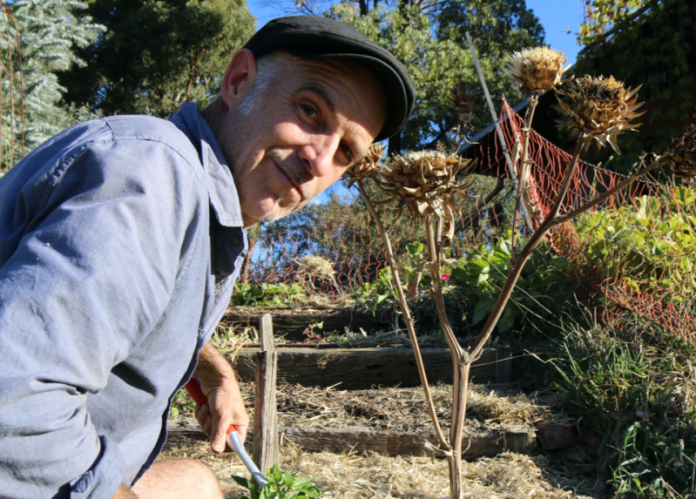When we are starting a new compost pile – be it bin or bay – it is good practice to start with a good layer of course, chopped up, carbon-rich ingredients at the bottom of the pile.
This ‘bedding’ will help the bottom of our pile to have good oxygen access in, and good carbon dioxide ventilation out of the pile, despite being right at the bottom of a heavy compost.
A big cubic metre compost bay, when full, can weigh over half a ton (500kg), and even a standard size Gedye-style bin can weigh more than 100kg when full. With all that weight above, we need our bedding layer to not squash down too easily, and not decompose into the compost too quickly.
So, what are the best ingredients to make this bedding layer out of, and how thick should it be?
Our favourite bedding ingredient when we build demonstration bays at YIMBY* workshops is the dry stems of globe artichokes. They strike just the right balance, being very coarse and chunky while still being full of air-spaces, breaking down slower than leaves and straw, but faster than woody branches, and ending mostly integrated into the humic compost substance after one or two passes through a full composting process.
Globe artichokes are very hardy (sometime described as ‘weedy’, they are a relative of the thistle), their flower stalks come up in early summer and the dry stems are compost gold (they also produce lots of juicy leaves that chop up easily for our composts over winter and spring too). Oh, and don’t forget their edible heart!
But, get creative, there are a range of other similarly ‘weedy’ plants that produce a great stem that is perfect for compost bedding. Autumn veggie garden clean-outs can provide the stems or stalks of; corn, sunflower, amaranth, silverbeet etc, all wonderful bedding material when chopped up to about 100-150mm.
I have seen small branches, chopped up short being used as, or part of, a bedding layer. Woody branches will do the aeration job well, but might take many passes through a compost process before being fully integrated into the compost.
As with everything else to do with compost, we still want a good diversity of ingredients, even in our bedding layer. To my chopped-up artichoke stems I like to add some coarse straw, some coarse wood chip and some other diverse veggie garden prunings. Together these make a good airy structure to build a compost pile on top of.
Our recommendation with most of the layers in our compost pile is to keep them thin, thin enough we can still see the layer underneath, at least a little bit. The bedding layer is an exception, it wants to be the thickest layer in the pile, at least 100mm, but even double that will work well.
Give your next compost pile the best start you can with a great bedding layer.
– Joel Meadows works with *Yes In My Back Yard, (YIMBY), a community-scale composting initiative in Castlemaine and surrounds. Send questions or comments to hello@yimbycompost.com, or to book in for a compost workshop.








